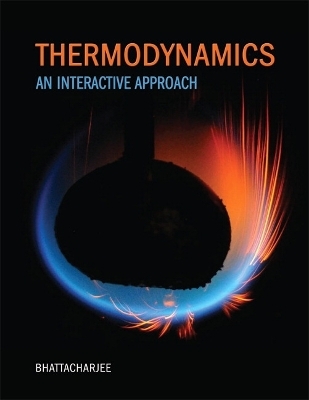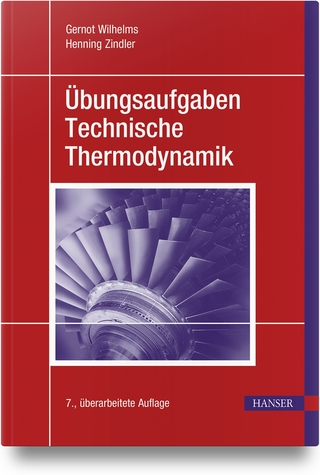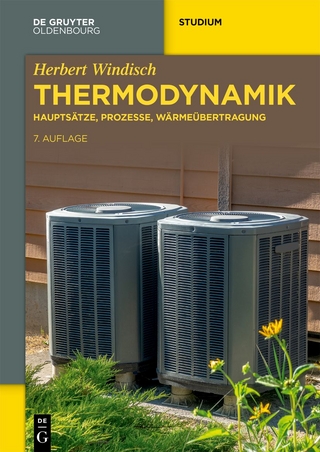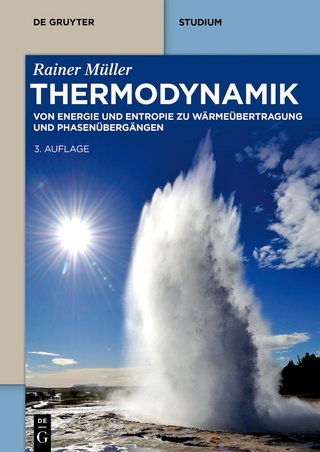
Thermodynamics
Pearson (Verlag)
978-0-13-035117-3 (ISBN)
- Titel erscheint in neuer Auflage
- Artikel merken
¿
Thermodynamics: An Interactive Approach employs a layered approach that introduces the important concepts of mass, energy, and entropy early, and progressively refines them throughout the text. To create a rich learning experience for today’s thermodynamics student, this book melds traditional content with the web-based resources and learning tools of TEST: The Expert System for Thermodynamics (www.pearsonhighered.com/bhattacharjee)–an interactive platform that offers smart thermodynamic tables for property evaluation and analysis tools for mass, energy, entropy, and exergy analysis of open and closed systems.
¿
Beside the daemons–web-based calculators with a friendly graphical interface–other useful TEST modules include an animation library, rich Internet applications (RIAs), traditional charts and tables, manual and TEST solutions of hundreds of engineering problems, and examples and problems to supplement the textbook. The book is written in a way that allows instructors to decide the extent that TEST is integrated with homework or in the classroom.
¿
MasteringEngineering for Thermodynamics is a total learning package. This innovative online program emulates the instructor’s office—hour environment, guiding students through engineering concepts from Thermodynamics with self-paced individualized coaching.
¿
Teaching and Learning Experience
To provide a better teaching and learning experience, for both instructors and students, this program will:
Personalize Learning with Individualized Coaching: MasteringEngineering emulates the instructor’s office-hour environment using self-paced individualized coaching.
Introduce Fundamental Theories Early: A layered approach introduces important concepts early, and progressively refines them in subsequent chapters to lay a foundation for true understanding.
Engage Students with Interactive Content: To create a rich learning experience for today’s thermodynamics student, this book melds traditional content with web-based resources and learning tools.
¿
Note: You are purchasing the standalone text. MasteringEngineering does not come automatically packaged with the text. To purchase MasteringEngineering, search for ISBN-10: 0133807975 / ISBN-13: 9780133807974. That package contains ISBN-10: 0130351172 / ISBN-13: 9780130351173 and ISBN-10: 0133810844 / ISBN-13: 9780133810844. MasteringEngineering is not a self-paced technology and should only be purchased when required by an instructor.
¿
Professor Subrata Bhattacharjee, known by his friends as Sooby, earned a B.Tech. degree in Mechanical Engineering from Indian Institute of Technology, Kharagpur in 1983 and his Ph.D. from Washington State University, Pullman, USA in 1988. After two years of post-doctoral work on a NASA project, he joined San Diego State University in 1991 and currently holds Professorship in Mechanical Engineering Department and Adjunct Professorship in Computer Science Department. Professor Bhattacharjee has been actively involved in research in radiation heat transfer, combustion, computational thermodynamics, and development of software for educational purposes. For his dissertation, he developed a modified two-flux method (Effective Angle Method) for calculating radiative source term and used this model to study two-way coupling between radiation and fluid dynamics in a laminar diffusion flame. Working on a project on jet flow in boundary layers, he came upon a new non-dimensional group that compares a known pressure drop with viscous forces. This number is being used in textbook and literature in connection with electronic cooling. Throughout his research career, Dr. Bhattacharjee has been interested in uncovering the mechanism of flame spread over solid fuels, especially in a microgravity environment. His work helped establish the dominance of radiation heat transfer in near quiescent environment. He has been a PI and co-PI of several projects funded by NASA. Some of his contributions include: 1. Discovery of the phenomenon that flame over thick fuel bed in a quiescent microgravity environment self-extinguishes irrespective of the oxygen level; 2. Development of a formula for a critical thickness that renders a fuel thick in such an environment; 3. Development of two formulas for flame spread rate, one in the thin limit and one in the thick limit, which are the only flame spread formulas ever developed in the microgravity regime. Several of his experiments on flames over solids have been conducted aboard NASA's Space Shuttles, Sounding Rockets, and Russia's Mir Space Station. One of his recently proposed experiments is currently under design to be conducted in the International Space Station. Under a current grant from NASA, Prof. Bhattacharjee and his team is building a 10 m tall Flame Tower at SDSU to conduct some fundamental experiments to predict the behavior of flames in a gravity free environment of a spacecraft. These ground based work is in support of the proposed space based experiment. In this work, researchers from Gifu University, Japan, are collaborating with SDSU. Supported by NSF, Dr. Bhattacharjee has been developing a novel cyber infrastructure for multi-scale approach to thermodynamic data and chemical equilibrium services. Users can now plug in these services and "outsource" the data used in their thermofluids calculations. By simply altering key words such as NASA, NIST, or AB-INITIO, for example, they can change the source of data used in their research applications. Likewise, equilibrium calculations can be integrated into any CFD code written in FORTRAN, MATLAB, or any other language through a relatively new technology called web services. The chemical equilibrium program developed by Dr. Bhattacharjee's group is equally powerful as NASA's benchmark CEA and offers a built-in parallel architecture. Prof. Bhattacharjee's passion for making thermodynamics easier to master led to the development of a web based software called TEST, the Expert System for thermodynamics (www.pearsonhighered.com/bhattacharjee), which has been used by students, professionals and educators from around the world. Several articles and one book have been written about the use of TEST in thermodynamic education. Winner of Outstanding Faculty Award, Monty Award at SDSU, Most Influential Faculty award, Faculty Friend Award, Outstanding Engineering Educator award, Best Paper award, and ASME Fellow award, Professor Bhattacharjee can be contacted at prof.bhattacharjee@gmail.com
0. Introduction Thermodynamic System and its Interactions with the Surroundings
0.1 Thermodynamic Systems
0.2 Test and Animations
0.3 Examples of Thermodynamic Systems
0.4 Interactions Between The System and its Surroundings
0.5 Mass Interaction
0.6 Test and the Daemons
0.7 Energy, Work, and Heat
0.7.1 Heat and Heating Rate (Q, Q)
0.7.2 Work and Power (W, W#)
0.8 Work Transfer Mechanisms
0.8.1 Mechanical Work (WM, W#M)
0.8.2 Shaft Work (Wsh, W#sh)
0.1.5 Electrical Work (Wel , Wel#)
0.8.3 Boundary Work (WB, W#B)
0.8.4 Flow Work (W#F)
0.8.5 Net Work Transfer (W#, Wext)
0.8.6 Other Interactions
0.9 Closure
1. Description of a System: States And Properties
1.1 Consequences of Interactions
1.2 States
1.3 Macroscopic vs. Microscopic Thermodynamics
1.4 An Image Analogy
1.5 Properties of State
1.5.1 Property Evaluation by State Daemons
1.5.2 Properties Related to System Size (V, A, m, n, m # , V#, n # )
1.5.3 Density and Specific Volume (r, v)
1.5.4 Velocity and Elevation (V, z)
1.5.5 Pressure (p)
1.5.6 Temperature (T)
1.5.7 Stored Energy (E, KE, PE, U, e, ke, pe, u, E#)
1.5.8 Flow Energy and Enthalpy (j, J#, h, H#)
1.5.9 Entropy (S, s)
1.5.10 Exergy (f, c)
1.6 Property Classification
1.7 Evaluation of Extended State
1.8 Closure
2. Development of Balance Equations for Mass, Energy, and Entropy: Application to Closed-Steady Systems
2.1 Balance Equations
2.1.1 Mass Balance Equation
2.1.2 Energy Balance Equation
2.1.3 Entropy Balance Equation
2.1.4 Entropy and Reversibility
2.2 Closed-Steady Systems
2.3 Cycles—a Special Case of Closed-Steady Systems
2.3.1 Heat Engine
2.3.2 Refrigerator and Heat Pump
2.3.3 The Carnot Cycle
2.3.4 The Kelvin Temperature Scale
2.4 Closure
3. Evaluation of Properties: Material Models
3.1 Thermodynamic Equilibrium and States
3.1.1 Equilibrium and LTE (Local Thermodynamic Equilibrium)
3.1.2 The State Postulate
3.1.3 Differential Thermodynamic Relations
3.2 Material Models
3.2.1 State Daemons and TEST-Codes
3.3 The SL (Solid>Liquid) Model
3.3.1 SL Model Assumptions
3.3.2 Equations of State
3.3.3 Model Summary: SL Model
3.4 The PC (Phase-Change) Model
3.4.1 A New Pair of Properties—Qualities x and y
3.4.2 Numerical Simulation
3.4.3 Property Diagrams
3.4.4 Extending the Diagrams: The Solid Phase
3.4.5 Thermodynamic Property Tables
3.4.6 Evaluation of Phase Composition
3.4.7 Properties of Saturated Mixture
3.4.8 Subcooled or Compressed Liquid
3.4.9 Supercritical Vapor or Liquid
3.4.10 Sublimation States
3.4.11 Model Summary—PC Model
3.5 GAS MODELS
3.5.1 The IG (Ideal Gas) and PG (Perfect Gas) Models
3.5.2 IG and PG Model Assumptions
3.5.3 Equations of State
3.5.4 Model Summary: PG and IG Models
3.5.5 The RG (Real Gas) Model
3.5.6 RG Model Assumptions
3.5.7 Compressibility Charts
3.5.8 Other Equations of State
3.5.9 Model Summary: RG Model
3.6 Mixture Models
3.6.1 Vacuum
3.7 Standard Reference State and Reference Values
3.8 Selection of a Model
3.9 Closure
4. Mass, Energy, and Entropy Analysis of Open-Steady Systems
4.1 Governing Equations and Device Efficiencies
4.1.1 TEST and the Open-Steady Daemons
4.1.2 Energetic Efficiency
4.1.3 Internally Reversible System
4.1.4 Isentropic Efficiency
4.2 Comprehensive Analysis
4.2.1 Pipes, Ducts, or Tubes
4.2.2 Nozzles and Diffusers
4.2.3 Turbines
4.2.4 Compressors, Fans, and Pumps
4.2.5 Throttling Valves
4.2.6 Heat Exchangers
4.2.7 TEST and the Multi-Flow Non-Mixing Daemons
4.2.8 Mixing Chambers and Separators
4.2.9 TEST and the Multi-Flow Mixing Daemons
4.3 Closure
5. Mass, Energy, and Entropy Analysis of Unsteady Systems
5.1 Unsteady Processes
5.1.1 Closed Processes
5.1.2 TEST and the Closed-Process Daemons
5.1.3 Energetic Efficiency and Reversibility
5.1.4 Uniform Closed Processes
5.1.5 Non-Uniform Systems
5.1.6 TEST and the Non-Uniform Closed-Process Daemons
5.1.7 Open Processes
5.1.8 TEST and Open-Process Daemons
5.2 Transient Analysis
5.2.1 Closed Transient Systems
5.2.2 Isolated Systems
5.2.3 Mechanical Systems
5.2.4 Open Transient Systems
5.3 Differential Processes
5.4 Thermodynamic Cycle as a Closed Process
5.4.1 Origin of Internal Energy
5.4.2 Clausius Inequality and Entropy
5.5 Closure
6. Exergy Balance Equation: Application to Steady and Unsteady Systems
6.1 Exergy Balance Equation
6.1.1 Exergy, Reversible Work, and Irreversibility
6.1.2 TEST Daemons for Exergy Analysis
6.2 Closed-Steady Systems
6.2.1 Exergy Analysis of Cycles
6.3 Open-Steady Systems
6.4 Closed Processes
6.5 Open Processes
6.6 Closure
7. Reciprocating Closed Power Cycles
7.1 The Closed Carnot Heat Engine
7.1.1 Significance of the Carnot Engine
7.2 IC Engine Terminology
7.3 Air-Standard Cycles
7.3.1 TEST and the Reciprocating Cycle Daemons
7.4 Otto Cycle
7.4.1 Cycle Analysis
7.4.2 Qualitative Performance Predictions
7.4.3 Fuel Consideration
7.5 Diesel Cycle
7.5.1 Cycle Analysis
7.5.2 Fuel Consideration
7.6 Dual Cycle
7.7 Atkinson and Miller Cycles
7.8 Stirling Cycle
7.9 Two-Stroke Cycle
7.10 Fuels
7.11 Closure
8. Open Gas Power Cycle
8.1 The Gas Turbine
8.2 The Air-Standard Brayton Cycle
8.2.1 TEST and the Open Gas Power-Cycle Daemons
8.2.2 Fuel Consideration
8.2.3 Qualitative Performance Predictions
8.2.4 Irreversibilities in an Actual Cycle
8.2.5 Exergy Accounting of Brayton Cycle
8.3 Gas Turbine With Regeneration
8.4 Gas Turbine With Reheat
8.5 Gas Turbine With Intercooling and Reheat
8.6 Regenerative Gas Turbine With Reheat and Intercooling
8.7 Gas Turbines For Jet Propulsion
8.7.1 The Momentum Balance Equation
8.7.2 Jet Engine Performance
8.7.3 Air-Standard Cycle for Turbojet Analysis
8.8 Other Forms of Jet Propulsion
8.9 Closure
9. Open Vapor Power Cycles
9.1 The Steam Power Plant
9.2 The Rankine Cycle
9.2.1 Carbon Footprint
9.2.2 TEST and the Open Vapor Power Cycle Daemons
9.2.3 Qualitative Performance Predictions
9.2.4 Parametric Study of the Rankine Cycle
9.2.5 Irreversibilities in an Actual Cycle
9.2.6 Exergy Accounting of Rankine Cycle
9.3 Modification of Rankine Cycle
9.3.1 Reheat Rankine Cycle
9.3.2 Regenerative Rankine Cycle
9.4 Cogeneration
9.5 Binary Vapor Cycle
9.6 Combined Cycle
9.7 Closure
10. Refrigeration Cycles
10.1 Refrigerators and Heat Pump
10.2 Test and the Refrigeration Cycle Daemons
10.3 Vapor-Refrigeration Cycles
10.3.1 Carnot Refrigeration Cycle
10.3.2 Vapor Compression Cycle
10.3.3 Analysis of an Ideal Vapor-Compression Refrigeration Cycle
10.3.4 Qualitative Performance Predictions
10.3.5 Actual Vapor-Compression Cycle
10.3.6 Components of a Vapor-Compression Plant
10.3.7 Exergy Accounting of Vapor Compression Cycle
10.3.8 Refrigerant Selection
10.3.9 Cascade Refrigeration Systems
10.3.10 Multistage Refrigeration with Flash Chamber
10.4 Absorption Refrigeration Cycle
10.5 Gas Refrigeration Cycles
10.5.1 Reversed Brayton Cycle
10.5.2 Linde-Hampson Cycle
10.6 Heat Pump Systems
10.7 Closure
11. Evaluation of Properties: Thermodynamic Relations
11.1 Thermodynamic Relations
11.1.1 The Tds Relations
11.1.2 Partial Differential Relations
11.1.3 The Maxwell Relations
11.1.4 The Clapeyron Equation
11.1.5 The Clapeyron-Clausius Equation
11.2 Evaluation of Properties
11.2.1 Internal Energy
11.2.2 Enthalpy
11.2.3 Entropy
11.2.4 Volume Expansivity and Compressibility
11.2.5 Specific Heats
11.2.6 Joule-Thompson Coefficient
11.3 The Real Gas (RG) Model
11.4 Mixture Models
11.4.1 Mixture Composition
11.4.2 Mixture Daemons
11.4.3 PG and IG Mixture Models
11.4.4 Mass, Energy, and Entropy Equations for IG-Mixtures
11.4.5 Real Gas Mixture Model
11.5 Closure
12. Psychrometry
12.1 The Moist Air Model
12.1.1 Model Assumptions
12.1.2 Saturation Processes
12.1.3 Absolute and Relative Humidity
12.1.4 Dry- and Wet-Bulb Temperatures
12.1.5 Moist Air (MA) Daemons
12.1.6 More properties of Moist Air
12.2 Mass And Energy Balance Equations
12.2.1 Open-Steady Device
12.2.2 Closed Process
12.3 Adiabatic Saturation and Wet-Bulb Temperature
12.4 Psychrometric Chart
12.5 Air-Conditioning Processes
12.5.1 Simple Heating or Cooling
12.5.2 Heating with Humidification
12.5.3 Cooling with Dehumidification
12.5.4 Evaporative Cooling
12.5.5 Adiabatic Mixing
12.5.6 Wet Cooling Tower
12.6 Closure
13. Combustion
13.1 Combustion Reaction
13.1.1 Combustion Daemons
13.1.2 Fuels
13.1.3 Air
13.1.4 Combustion Products
13.2 System Analysis
13.3 Open-Steady Device
13.3.1 Enthalpy of Formation
13.3.2 Energy Analysis
13.3.3 Entropy Analysis
13.3.4 Exergy Analysis
13.3.5 Isothermal Combustion—Fuel Cells
13.3.6 Adiabatic Combustion—Power Plants
13.4 Closed Process
13.5 Combustion Efficiencies
13.6 Closure
14. Equilibrium
14.1 Criteria for Equilibrium
14.2 Equilibrium of Gas Mixtures
14.3 Phase Equilibrium
14.3.1 Osmotic Pressure and Desalination
14.4 Chemical Equilibrium
14.4.1 Equilibrium Daemons
14.4.2 Equilibrium Composition
14.5 Closure
15. Gas Dynamics
15.1 One-Dimensional Flow
15.1.1 Static, Stagnation and Total Properties
15.1.2 The Gas Dynamics Daemon
15.2 Isentropic Flow of a Perfect Gas
15.3 Mach Number
15.4 Shape of an Isentropic Duct
15.5 Isentropic Table for Perfect Gases
15.6 Effect of Back Pressure: Converging Nozzle
15.7 Effect of Back Pressure: Converging-Diverging Nozzle
15.7.1 Normal Shock
15.7.2 Normal Shock in a Nozzle
15.8 Nozzle and Diffuser Coefficients
15.9 Closure
Appendices
Glossary
Index
| Erscheint lt. Verlag | 2.12.2014 |
|---|---|
| Sprache | englisch |
| Maße | 220 x 285 mm |
| Gewicht | 1600 g |
| Themenwelt | Naturwissenschaften ► Physik / Astronomie ► Thermodynamik |
| Technik ► Maschinenbau | |
| ISBN-10 | 0-13-035117-2 / 0130351172 |
| ISBN-13 | 978-0-13-035117-3 / 9780130351173 |
| Zustand | Neuware |
| Informationen gemäß Produktsicherheitsverordnung (GPSR) | |
| Haben Sie eine Frage zum Produkt? |
aus dem Bereich


